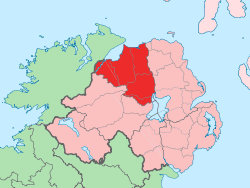Maghera
Maghera (pronounced /ˌmɑːhəˈrɑː/ MAH-hə-RAH, from Irish: Machaire Rátha, meaning "plain of the ringfort") is a small town in County Londonderry, Northern Ireland. Its population was 4,220 in the 2011 Census,[2] increasing from 3,711 in the 2001 Census.[3] It is situated within Mid-Ulster District, as well as the civil parish of Maghera, which it was named after, and the former barony of Loughinsholin.
| Maghera | |
|---|---|
 Maghera Town Centre | |
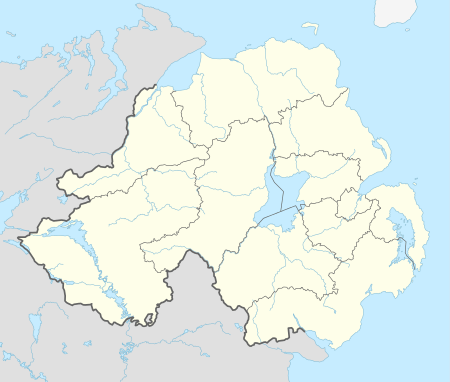 Maghera Location within Northern Ireland | |
| Population | 4,220 (2011 Census) |
| District |
|
| County | |
| Country | Northern Ireland |
| Sovereign state | United Kingdom |
| Post town | MAGHERA |
| Postcode district | BT46 |
| Dialling code | 028 |
| Police | Northern Ireland |
| Fire | Northern Ireland |
| Ambulance | Northern Ireland |
| UK Parliament |
|
| NI Assembly |
|
History
The town dates back at least to the 6th century to the monastery founded by St. Lurach whose family were possibly evangelised by St. Patrick. The Annals of Ulster say that the seat of the Cenél nEoghain was at Ráth Luraig in Maghera. The church in Maghera is named after St Lurach.[4]
The town became a settlement for Scottish settlers in the 17th century who came into conflict with the indigenous residents. For example, on 12 July 1830, Orange Order marches led to clashes between Orangemen and Ribbonmen in Maghera and Castledawson. Several Catholic homes were then burnt by Protestants following these clashes.[5]
The Troubles
Maghera suffered significant violence during the Troubles. In total, 14 people were killed, half of them members of the security forces and a further two as a result of family membership of the Ulster Defence Regiment. The Provisional Irish Republican Army were responsible for ten of the deaths.
Governance
The town is part of the Mid-Ulster District Council. It is located within the Carntogher district electoral area (DLE) which contains the areas Lower Glenshane, Swatragh, Tamlaght O'Crilly, Valley and Maghera.[6] In the 2015 district elections, Carntogher DLE elected three Sinn Féin, one SDLP and one DUP representatives to the council.
Places of interest
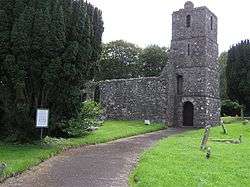
Notable buildings in Maghera include St Lurach's Church, which was founded in the year 500AD, originally as a monastery. The town of Maghera grew up around this church. The importance of the monastery was such that Maghera was a bishop's seat in the 12th and 13th centuries.[7] However, the Church was raided by the Vikings and fell into disrepair and is now maintained by the Environmental Heritage Service. Within the ruins, as an inset to the west wall is a sculpture of the crucifixion, which is thought to date from the 10th century – making it one of the earliest surviving representations of the crucifixion in Ireland. St Lurach is also the saint of the town.[8] The oldest linen mill in Ireland, the William Clark & Sons company founded in 1736, is in the town.[9]
Churches
In St Patrick's Roman Catholic church, there is a headstone remembering the large number of people who died in the parish during the Famine. In the local Church of Ireland parish of St. Lurach's there is a memorial dedicated to the memory of the local men and women who died in both world wars. The Presbyterian church has a brass plaque in memory of those who served during the First World War. Both Protestant churches have memorials to local victims on IRA violence. The Church of Ireland has memorials to Alan Clark and John Proctor murdered by the IRA. The Presbyterian church has a memorial window to UDR and RUC members murdered by the IRA.
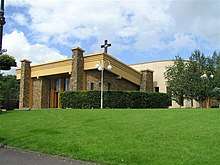
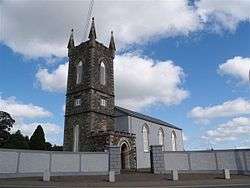
Transport
Maghera railway station opened on 18 December 1880, shut for passenger traffic on 28 August 1950 and shut altogether on 1 October 1959.[10]

People
- Charles Thomson (1729–1824), emigrated to the United States where he became secretary of the Continental Congress.
- Dr Henry Cooke (1788–1868), noted Presbyterian theologian, statue to him (known as the Black Man) erected in Belfast.
- James Johnston Clark (1809–1891), MP for County Londonderry, born at Largantogher House.
- Watty Graham (1768-1798), member of the United Irishmen, involved in the rebellion and executed in 1798.
- Robert Hawthorne (1822–1879), won a Victoria Cross during the Indian Mutiny.
- William Shiels (1848–1904), Australian colonial politician and 16th Premier of Victoria, was born in Maghera.
- James Lenox-Conyngham Chichester-Clark (1884–1933), MP for County Londonderry, born at Largantogher House.
- Eve Bunting (1928– ), children's author was born in Maghera; she later emigrated to the United States.
- John Kelly (1936–2007), Sinn Féin politician; born in Belfast but moved to Maghera.
Schools
There are three primary schools and one secondary school in Maghera.
Primary schools
- St Mary's Primary School, Glenview
- Maghera Controlled Primary School
- St Patrick's Primary School, Glen
Secondary school
- St. Patrick's College, a co-educational college.
Former secondary school
- Maghera High School, which had an intake mainly from the local Protestant population, was shut in 2009 after a lengthy campaign by many locals to save it. Most of the remaining pupils were transferred to nearby Magherafelt High School.
Sport
- The local Gaelic football club is Watty Graham's Gaelic Athletic Club.
- The local football team is Maghera Strollers F.C.
- The nearest golf driving range is at Tobermore.
- The local leisure centre is Maghera Leisure Centre, on the Coleraine Road.
- The local Cycling Club is Carn Wheelers
- The local Cricket Club is Maghera Cricket Club.
References
- The Online Scots Dictionary Retrieved 20 August 2012.
- "Census 2011 Usually Resident Population: KS101NI - Table view". Northern Ireland Statistics and Research Agency (NISRA). p. 6. Retrieved 30 July 2019.
- "Census 2001 Usually Resident Population: KS01 (Settlements) - Table view". Northern Ireland Statistics and Research Agency (NISRA). p. 5. Retrieved 30 July 2019.
- "Maghera Parish Church". Retrieved 5 September 2019.
- "Parades and Marches – Chronology 2: Historical Dates and Events". Conflict Archive on the Internet. Retrieved 28 January 2010.
- "Mid-Ulster District Council". Retrieved 5 September 2019.
- TG4 documentary
- TG4 documentary
- The Maghera and District Genealogical & History Society, accessed 3 July 2017
- "Maghera station" (PDF). Railscot – Irish Railways. Retrieved 28 September 2011.
